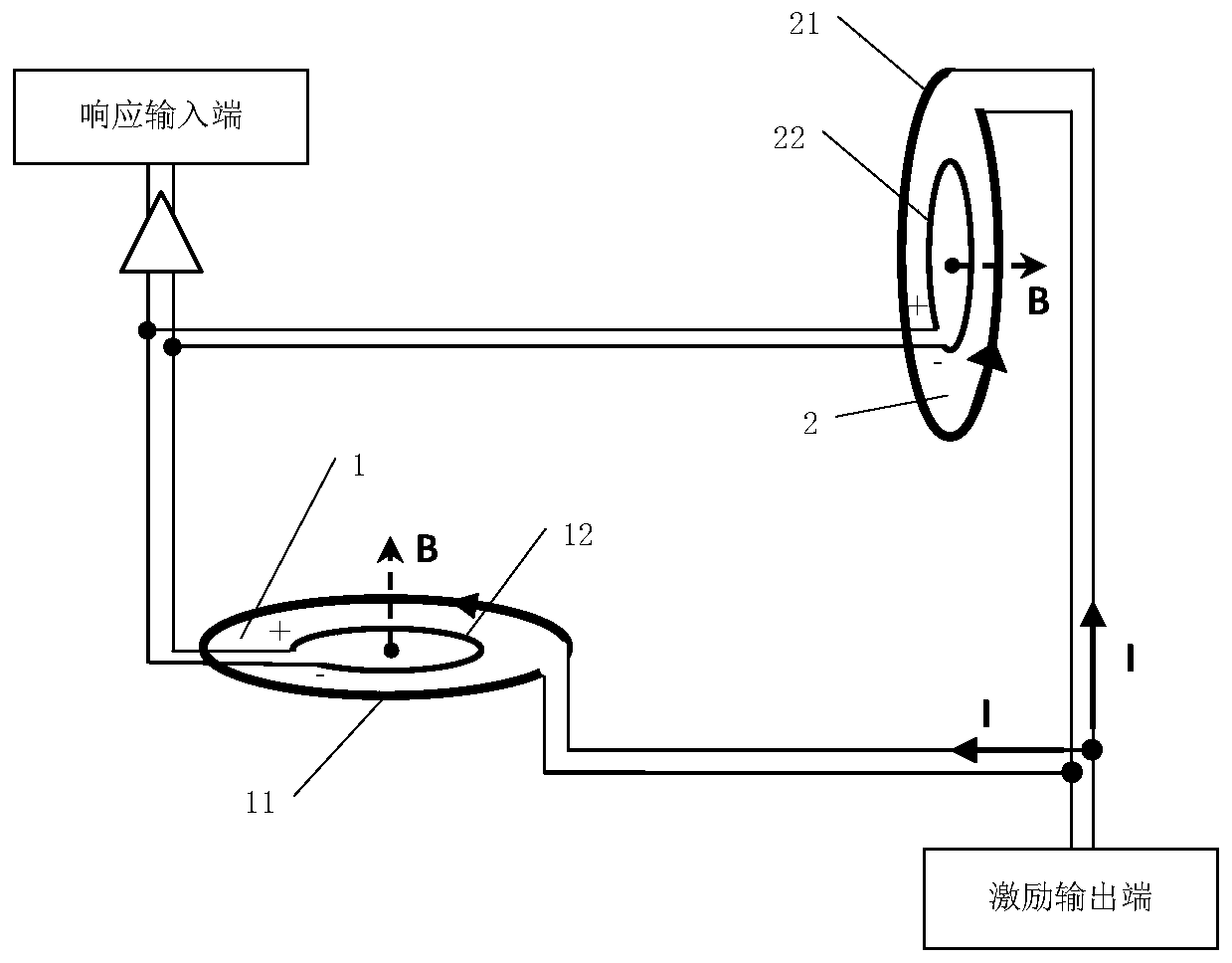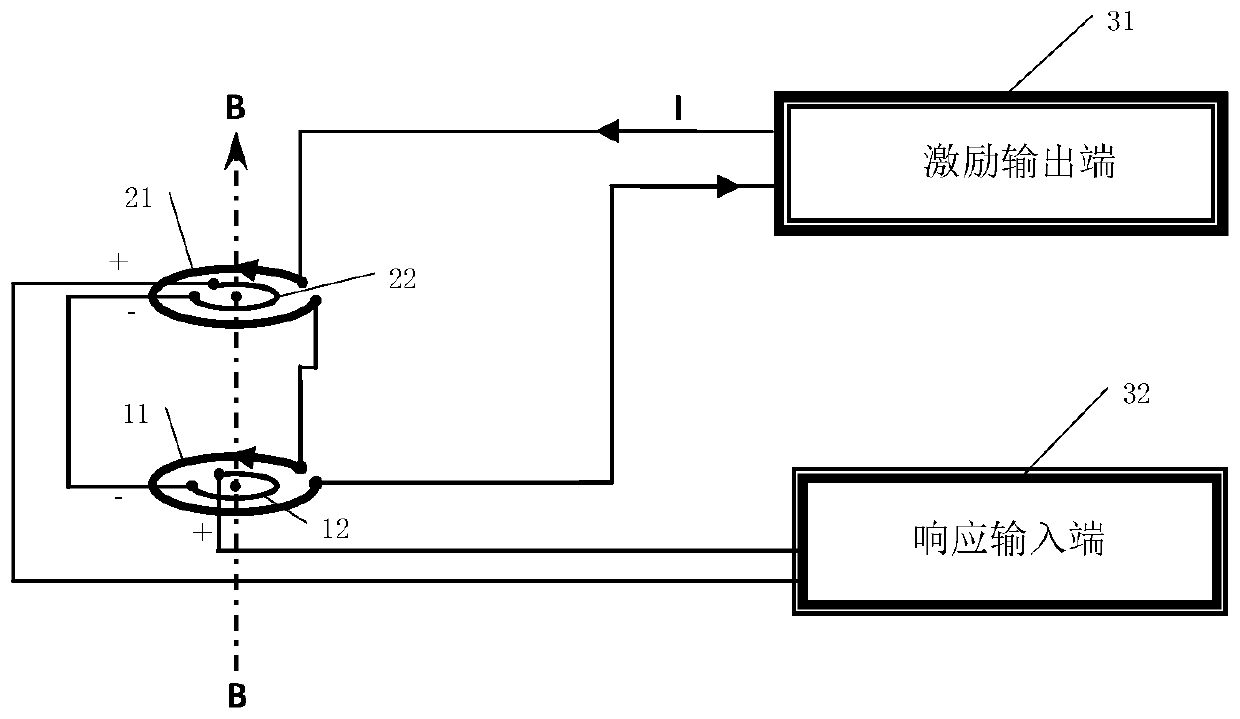Electromagnetic excitation response signal mutual inductance device, detection device and detection method
A technology that responds to signals and electromagnetic excitation, applied in the field of physical detection, can solve the problems of discounted excitation strength, weakened excitation signal, and limited exploration capabilities, etc., and achieves the effect of low production cost and wide application
- Summary
- Abstract
- Description
- Claims
- Application Information
AI Technical Summary
Problems solved by technology
Method used
Image
Examples
Embodiment 1
[0043] Please also refer to figure 1 , the present invention provides an electromagnetic excitation response signal mutual induction device, including a detector, a comparator installed at the geometric position of the detector;
[0044] The detector 1 includes a main excitation source 11 and a main receiving probe 12;
[0045] The comparator 2 includes a standby excitation source 21 and a standby receiving probe 22;
[0046] The main excitation source 11 is connected in parallel or in series with the standby excitation source 21; ensure that the current direction of the received excitation signal is the same;
[0047] The main receiving probe 12 and the standby receiving probe 22 are connected in anti-parallel or anti-series.
[0048] Specifically, in the mutual induction device provided by the present invention, the main function of the detector 1 is to perform point-by-point detection on the medium to be measured, and the main function of the comparator 2 is to filter out...
Embodiment 2
[0063] For details, please refer to figure 2 , the present invention also provides an electromagnetic excitation response signal detection device, using the mutual induction device in Embodiment 1, and also comprising an electromagnetic observer; the electromagnetic observer includes an excitation output terminal and a response input terminal;
[0064] The main excitation source 11 and the standby excitation source 21 are connected in parallel / serial connection respectively with the excitation output terminal 31 of the electromagnetic observer;
[0065] The main receiving probe 12 and the standby receiving probe 22 are connected in antiparallel / reverse series, respectively, to the response input end 32 of the electromagnetic observer.
[0066] Specifically, the excitation output terminal 31 has two terminals, corresponding to the output and input of the electromagnetic excitation current; the response input terminal 32 has two terminals, respectively corresponding to the main...
Embodiment 3
[0075] Please also refer to figure 2 , the ring-shaped main excitation source 11 is wound with a wire with a diameter of 0.5 meters, a wire diameter of 2 square millimeters, and a number of turns of 10 turns, and the main receiving probe 12 is ring-wound with a wire with a diameter of 0.3 meters, a wire diameter of 1 square millimeter, and a number of turns of 100 turns , form the detector 1 with the main excitation source 11 and the main receiving probe 12 of the common center point and coplanar; The same received probe builds a comparator 2; the main excitation source 11 and the standby excitation source 21 are connected in parallel to form an excitation signal transmitting end, and the main receiving coil and the standby receiving coil are connected in reverse series to form an electromagnetic response signal Receiving end. The transient electromagnetic instrument is used as the electromagnetic observer.
[0076] After testing experiments, in free air, if the planes wher...
PUM
 Login to View More
Login to View More Abstract
Description
Claims
Application Information
 Login to View More
Login to View More - R&D
- Intellectual Property
- Life Sciences
- Materials
- Tech Scout
- Unparalleled Data Quality
- Higher Quality Content
- 60% Fewer Hallucinations
Browse by: Latest US Patents, China's latest patents, Technical Efficacy Thesaurus, Application Domain, Technology Topic, Popular Technical Reports.
© 2025 PatSnap. All rights reserved.Legal|Privacy policy|Modern Slavery Act Transparency Statement|Sitemap|About US| Contact US: help@patsnap.com



